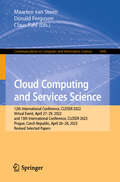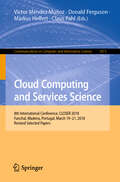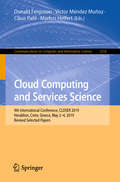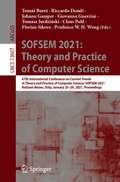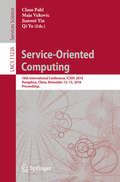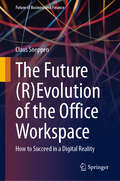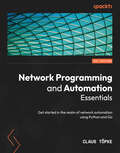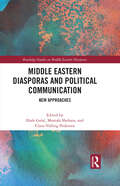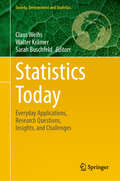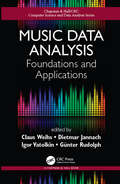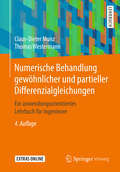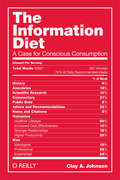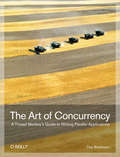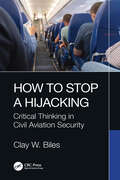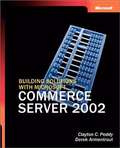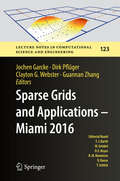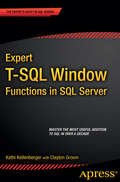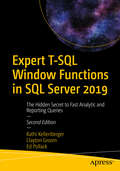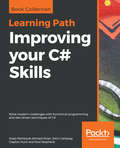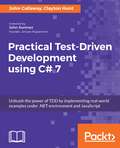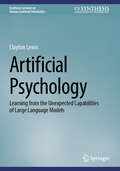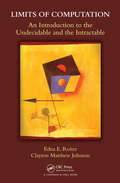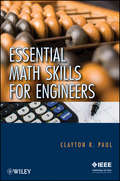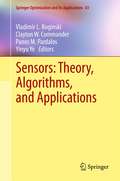- Table View
- List View
Cloud Computing and Services Science: 12th International Conference, CLOSER 2022, Virtual Event, April 27–29, 2022, and 13th International Conference, CLOSER 2023, Prague, Czech Republic, April 26–28, 2023, Revised Selected Papers (Communications in Computer and Information Science #1845)
by Donald Ferguson Maarten Van Steen Claus PahlThis book constitutes revised selected papers from the 12th and 13th International Conference on Cloud Computing and Services Science , CLOSER 2022 and CLOSER 2023, which took place as a virtual event in April 2022 and in Prague, Czech Republic, in April 2023. CLOSER 2022 received a total of 45 submissions out of which 3 papers are included in this book. From 46 submissions received for CLOSER 2023, 7 papers have been selected for inclusion in this book. They focus on latest advances and various aspects of cloud computing and the link to services science.
Cloud Computing and Services Science: 8th International Conference, CLOSER 2018, Funchal, Madeira, Portugal, March 19-21, 2018, Revised Selected Papers (Communications in Computer and Information Science #1073)
by Markus Helfert Donald Ferguson Víctor Méndez Muñoz Claus PahlThis book constitutes extended, revised and selected papers from the 8th International Conference on Cloud Computing and Services Science, CLOSER 2018, held in Funchal, Portugal in March 2018. The 11 papers presented in this volume were carefully reviewed and selected from a total of 94 submissions. CLOSER 2018 focused on the emerging area of Cloud Computing, inspired by some latest advances that concern the infrastructure, operations and available services throughout the global network.
Cloud Computing and Services Science: 9th International Conference, CLOSER 2019, Heraklion, Crete, Greece, May 2–4, 2019, Revised Selected Papers (Communications in Computer and Information Science #1218)
by Markus Helfert Donald Ferguson Víctor Méndez Muñoz Claus PahlThis book constitutes extended, revised and selected papers from the 9th International Conference on Cloud Computing and Services Science, CLOSER 2019, held in Heraklion, Greece, in May 2019.The 11 papers presented in this volume were carefully reviewed and selected from a total of 102 submissions. CLOSER 2019 focuses on the emerging area of Cloud Computing, inspired by some latest advances that concern the infrastructure, operations, and available servicesthrough the global network.
SOFSEM 2021: 47th International Conference on Current Trends in Theory and Practice of Computer Science, SOFSEM 2021, Bolzano-Bozen, Italy, January 25–29, 2021, Proceedings (Lecture Notes in Computer Science #12607)
by Giovanna Guerrini Riccardo Dondi Johann Gamper Claus Pahl Florian Sikora Tomáš Bureš Tomasz Jurdziński Prudence W. H. WongThis book contains the invited and contributed papers selected for presentation at SOFSEM 2021, the 47th International Conference on Current Trends in Theory and Practice of Computer Science, which was held online during January 25–28, 2021, hosted by the Free University of Bozen-Bolzano, Italy.The 33 full and 7 short papers included in the volume were carefully reviewed and selected from 100 submissions. They were organized in topical sections on: foundations of computer science; foundations of software engineering; foundations of data science and engineering; and foundations of algorithmic computational biology. The book also contains 5 invited papers.
Service-Oriented Computing: 16th International Conference, ICSOC 2018, Hangzhou, China, November 12-15, 2018, Proceedings (Lecture Notes in Computer Science #11236)
by Qi Yu Claus Pahl Maja Vukovic Jianwei YinThis book constitutes the proceedings of the 16th International Conference on Service-Oriented Computing, ICSOC 2018, held in Hangzhou, China, in November 2018. The 63 full papers presented together with 3 keynotes in this volume were carefully reviewed and selected from numerous submissions. The papers have been organized in the following topical sections: Microservices; Services and Processes; Service Trust and Security; Business Services and Processes; Edge + IoT Services; Social and Interactive Services; Recommendation; Service Analytics; Quality of Service; Service Engineering; Service Applications; Service Management.
The Future: How to Succeed in a Digital Reality (Future of Business and Finance)
by Claus SneppenThe redefined meaning of the office workplace for knowledge workers that is currently taking place impacts all workplace actors to different extents. There is no exact formula or framework for a successful hybrid working life, thus society cannot anticipate the future of the hybrid office workplaces and work life will look like for office work. This means that workplaces need to continuously alter and evolved their workplace models. This book provides workers and managers with a nuanced understanding of the changes that have been realized, are nearing realization, or will drive the transformation of the hybrid workplace going forward. It offers recommendations and a framework to assist organizations to develop optimal hybrid workplace models, focusing on major trends and component shaping this evolution.
Network Programming and Automation Essentials: Get started in the realm of network automation using Python and Go
by Claus TopkeUnleash the power of automation by mastering network programming fundamentals using Python and Go best practicesPurchase of the print or Kindle book includes a free PDF eBookKey FeaturesUnderstand the fundamentals of network programming and automationLearn tips and tricks to transition from traditional networking to automated networksSolve everyday problems with automation frameworks in Python and GoBook DescriptionNetwork programming and automation, unlike traditional networking, is a modern-day skill that helps in configuring, managing, and operating networks and network devices. This book will guide you with important information, helping you set up and start working with network programming and automation.With Network Programming and Automation Essentials, you'll learn the basics of networking in brief. You'll explore the network programming and automation ecosystem, learn about the leading programmable interfaces, and go through the protocols, tools, techniques, and technologies associated with network programming. You'll also master network automation using Python and Go with hands-on labs and real network emulation in this comprehensive guide.By the end of this book, you'll be well equipped to program and automate networks efficiently.What you will learnUnderstand the foundation of network programmingExplore software-defined networks and related familiesRecognize the differences between Go and Python through comparisonLeverage the best practices of Go and PythonCreate your own network automation testing framework using network emulationAcquire skills in using automation frameworks and strategies for automationWho this book is forThis book is for network architects, network engineers, and software professionals looking to integrate programming into networks. Network engineers following traditional techniques can use this book to transition into modern-day network automation and programming. Familiarity with networking concepts is a prerequisite.
Middle Eastern Diasporas and Political Communication: New Approaches (Routledge Studies on Middle Eastern Diasporas)
by Ehab Galal Mostafa Shehata Claus Valling PedersenThis edited book explores the development and reconfiguration of Middle Eastern diasporic communities in the West in the context of increased political turmoil, civil war, new authoritarianism, and severe constraints on media in the Middle East. Taking an interdisciplinary approach, incorporating political and intercultural communication, the contributors investigate the rationale for diasporic politics, as well as the role of the transnational media in shaping diasporic political mobilization. This analysis of the media, situated within specific case studies, encompassing Afghani, Armenian, Bahraini, Egyptian, Lebanese, Syrian, Tunisian, and Turkish diasporic communities, reveals the variegated ways it influences diasporic politics and facilitates political action, as well as its influence on democratic actors residing in the Middle East. These new insights into Middle Eastern diasporas, political communication, and political mobilization are based on developments in the Middle East since 2011, and ultimately highlight how diaspora groups in the West relate to the situation in the Middle East, particularly in their countries of origin. The book is important reading for students and researchers working in political/intercultural communication and diasporic politics, as well as those with a general interest in the Middle East.
Statistics Today: Everyday Applications, Research Questions, Insights, and Challenges (Society, Environment and Statistics)
by Walter Krämer Claus Weihs Sarah BuschfeldThis book offers a broad selection of statistical applications to everyday situations, illustrating how exciting and diverse statistical analysis can be. It covers a wide variety of topics, including offering hearing-impaired people the option to enjoy music, extracting meaningful quantitative data from texts, and modeling flood disasters to help get a better grip on them. Most of the examples are not typically found in textbooks but directly relate to real-life problems encountered by the “average person”, including topics relevant for sustainable development.Technical jargon and formalism have been avoided as much as possible, and a detailed statistical background is not assumed of the reader, making the book accessible to anyone interested in current research in statistical applications. Providing an unobscured look at a thoroughly fascinating science, it will help students to develop enthusiasm for statistical issues and methods, and may even inspire ideas for their own projects.
Music Data Analysis: Foundations and Applications (Chapman & Hall/CRC Computer Science & Data Analysis)
by Claus Weihs, Dietmar Jannach, Igor Vatolkin and Günter RudolphThis book provides a comprehensive overview of music data analysis, from introductory material to advanced concepts. It covers various applications including transcription and segmentation as well as chord and harmony, instrument and tempo recognition. It also discusses the implementation aspects of music data analysis such as architecture, user interface and hardware. It is ideal for use in university classes with an interest in music data analysis. It also could be used in computer science and statistics as well as musicology.
Numerische Behandlung gewöhnlicher und partieller Differenzialgleichungen: Ein anwendungsorientiertes Lehrbuch für Ingenieure
by Claus-Dieter Munz Thomas WestermannDie Autoren vermitteln die Herleitung numerischer Algorithmen zur Lösung von Differenzialgleichungen und geben einen Einblick in die praktische Implementierung. Anhand von Beispielen und Übungsaufgaben mit Problemstellungen aus der Ingenieurspraxis werden Eigenschaften und Einsatzbereiche der verschiedenen Verfahren erläutert. Die beiliegende CD-ROM enthält neben den Lösungswegen auch eine interaktive Version des Buchs. Mithilfe des Computer-Algebra-Systems MAPLE können die beschriebenen Verfahren direkt aus dem Text heraus ausgeführt werden.
The Information Diet
by Clay A. JohnsonThe modern human animal spends upwards of 11 hours out of every 24 in a state of constant consumption. Not eating, but gorging on information ceaselessly spewed from the screens and speakers we hold dear. Just as we have grown morbidly obese on sugar, fat, and flour--so, too, have we become gluttons for texts, instant messages, emails, RSS feeds, downloads, videos, status updates, and tweets. We're all battling a storm of distractions, buffeted with notifications and tempted by tasty tidbits of information. And just as too much junk food can lead to obesity, too much junk information can lead to cluelessness. The Information Diet shows you how to thrive in this information glut--what to look for, what to avoid, and how to be selective. In the process, author Clay Johnson explains the role information has played throughout history, and why following his prescribed diet is essential for everyone who strives to be smart, productive, and sane. In The Information Diet, you will: Discover why eminent scholars are worried about our state of attention and general intelligence Examine how today's media--Big Info--give us exactly what we want: content that confirms our beliefs Learn to take steps to develop data literacy, attention fitness, and a healthy sense of humor Become engaged in the economics of information by learning how to reward good information providers Just like a normal, healthy food diet, The Information Diet is not about consuming less--it's about finding a healthy balance that works for you
The Information Diet: A Case for Conscious Comsumption
by Clay A. JohnsonThis is a softcover version of the title released in 2011; there is no new material.The modern human animal spends upwards of 11 hours out of every 24 in a state of constant consumption. Not eating, but gorging on information ceaselessly spewed from the screens and speakers we hold dear. Just as we have grown morbidly obese on sugar, fat, and flour—so, too, have we become gluttons for texts, instant messages, emails, RSS feeds, downloads, videos, status updates, and tweets.We're all battling a storm of distractions, buffeted with notifications and tempted by tasty tidbits of information. And just as too much junk food can lead to obesity, too much junk information can lead to cluelessness. The Information Diet shows you how to thrive in this information glut—what to look for, what to avoid, and how to be selective. In the process, author Clay Johnson explains the role information has played throughout history, and why following his prescribed diet is essential for everyone who strives to be smart, productive, and sane.In The Information Diet, you will:Discover why eminent scholars are worried about our state of attention and general intelligenceExamine how today’s media—Big Info—give us exactly what we want: content that confirms our beliefsLearn to take steps to develop data literacy, attention fitness, and a healthy sense of humorBecome engaged in the economics of information by learning how to reward good information providersJust like a normal, healthy food diet, The Information Diet is not about consuming less—it’s about finding a healthy balance that works for you
The Art of Concurrency: A Thread Monkey's Guide to Writing Parallel Applications
by Clay BreshearsIf you're looking to take full advantage of multi-core processors with concurrent programming, this practical book provides the knowledge and hands-on experience you need. The Art of Concurrency is one of the few resources to focus on implementing algorithms in the shared-memory model of multi-core processors, rather than just theoretical models or distributed-memory architectures. The book provides detailed explanations and usable samples to help you transform algorithms from serial to parallel code, along with advice and analysis for avoiding mistakes that programmers typically make when first attempting these computations.Written by an Intel engineer with over two decades of parallel and concurrent programming experience, this book will help you:Understand parallelism and concurrencyExplore differences between programming for shared-memory and distributed-memoryLearn guidelines for designing multithreaded applications, including testing and tuningDiscover how to make best use of different threading libraries, including Windows threads, POSIX threads, OpenMP, and Intel Threading Building BlocksExplore how to implement concurrent algorithms that involve sorting, searching, graphs, and other practical computationsThe Art of Concurrency shows you how to keep algorithms scalable to take advantage of new processors with even more cores. For developing parallel code algorithms for concurrent programming, this book is a must.
How to Stop a Hijacking: Critical Thinking in Civil Aviation Security
by Clay W. BilesHijackings and bombings have plagued civil aviation since 1930 and air rage incidents are on the rise. While there is aircraft and inflight training available for air marshals, other first responders receive minimal training on inflight security awareness and protocols. There are no other resources currently available to flight crews or armed first responders that specifically address inflight security and how to address threats of disturbances on airplanes.How to Stop a Hijacking provides readers with fundamental principles on how to think more critically about onboard security threats. The aircraft cabin poses unique environment and security challenges, and first responders can apply security awareness and critical thinking skills to establish a safer environment in the cabin and airport for everyone onboard. The lessons in this book are driven with the central objective of teaching the reader how to counter inflight aggression and maintain tactical control of the cabin. Written by a former federal air marshal instructor, this book looks at the recent rash of air rage incidents and violence on airplanes, in addition to the real and ever-present threat of hijack or potential explosive device.How to Stop a Hijacking is a practical guide that offers methodological and tactically proven strategies for stopping violent acts onboard an aircraft inflight.
Building Solutions with Microsoft® Commerce Server 2002
by Clayton C. Peddy Derek ArmentroutNo matter what your organization sells, a well-executed commerce solution can extend your business globally, boost profitability, and help you seize new opportunities faster. Drawing from their extensive, in-the-field experience, online business experts Clayton Peddy and Derek Armentrout teach you to quickly build and deploy a scalable, high-performance site using Commerce Server 2002. They detail how to customize your own solution--incorporating components such as a product catalog, a shopping cart, user profiles, content management, and data-warehousing and analysis capabilities. You get focused, field-proven techniques and hands-on instruction--along with reusable Code Candy from real-world solutions. Discover how to: Determine the business and technical requirements for your site Create and manage user profiles and implement authentication Use Microsoft Content Management Server to manage page templates, images, product data, and other resources Design product catalogs that are easy to use and manage Build the browse, registration, and shopping cart pages Exploit little-known pipeline capabilities, such as inventory calculation and third-party order processing Capture and analyze data on user demographics and buying patterns Create campaigns, promotions, and awards for targeted users Manage site operations using the Business Desk modules Test, stage, and launch your solution
Sparse Grids and Applications - Miami 2016 (Lecture Notes in Computational Science and Engineering #123)
by Dirk Pflüger Jochen Garcke Clayton G. Webster Guannan ZhangSparse grids are a popular tool for the numerical treatment of high-dimensional problems. Where classical numerical discretization schemes fail in more than three or four dimensions, sparse grids, in their different flavors, are frequently the method of choice. This volume of LNCSE presents selected papers from the proceedings of the fourth workshop on sparse grids and applications, and demonstrates once again the importance of this numerical discretization scheme. The articles present recent advances in the numerical analysis of sparse grids in connection with a range of applications including computational chemistry, computational fluid dynamics, and big data analytics, to name but a few.
Expert T-SQL Window Functions in SQL Server
by Kathi Kellenberger Clayton GroomExpert T-SQL Window Functions in SQL Server takes you from any level of knowledge of windowing functions and turns you into an expert who can use these powerful functions to solve many T-SQL queries. Replace slow cursors and self-joins with queries that are easy to write and fantastically better performing, all through the magic of window functions. First introduced in SQL Server 2005, window functions came into full blossom with SQL Server 2012. They truly are one of the most notable developments in SQL in a decade, and every developer and DBA can benefit from their expressive power in solving day-to-day business problems. Begin using windowing functions like ROW_NUMBER and LAG, and you will discover more ways to use them every day. You will approach SQL Server queries in a different way, thinking about sets of data instead of individual rows. Your queries will run faster, they will be easier to write, and they will be easier to deconstruct and maintain and enhance in the future. Just knowing and using these functions is not enough. You also need to understand how to tune the queries. Expert T-SQL Window Functions in SQL Server explains clearly how to get the best performance. The book also covers the rare cases when older techniques are the best bet. Stop using cursors and self-joins to solve complicated queries. Become a T-SQL expert by mastering windowing functions. Teaches you how to use all the window functions introduced in 2005 and 2012. Provides real-world examples that you can experiment with in your own database. Explains how to get the best performance when using windowing functions. What you'll learn Create aggregations by defining sets of rows with the OVER clause. Calculate aggregates without losing the details. Rank and bucketize data for reporting purposes. Reduce and often eliminate self-joins. Reduce and often eliminate row-by-row cursor processing. Write simpler queries that perform with greater speed. Recognize situations when window functions make a difference. Who this book is for Expert T-SQL Window Functions in SQL Server is for the SQL Server database professionals who are ready to take on the biggest leap in query-writing expressiveness and performance to hit the SQL language in years. It's for developers and database administrators who may have heard about windowing functions, but who haven't had a chance to learn much about them. Expert T-SQL Window Functions in SQL Server is an excellent way for database professionals to get up to speed on these functions and put their benefits to work. Table of Contents 1. Looking through the Window 2. Discovering Ranking Functions 3. Aggregating with Window Functions 4. Tuning for Better Performance 5. Calculating Rolling and Running Aggregates 6. Adding Frames to the Window 7. Peaking at Other Rows 8. Understanding Statistical Functions 9. The Future of Window Functions
Expert T-SQL Window Functions in SQL Server 2019: The Hidden Secret to Fast Analytic and Reporting Queries
by Kathi Kellenberger Clayton Groom Ed PollackBecome an expert who can use window functions to solve T-SQL query problems. Replace slow cursors and self-joins with queries that are easy to write and perform better. This new edition provides expanded examples, including a chapter from the world of sports, and covers the latest performance enhancements through SQL Server 2019. Window functions are useful in analytics and business intelligence reporting. They came into full blossom with SQL Server 2012, yet they are not as well known and used as often as they ought to be. This group of functions is one of the most notable developments in SQL, and this book shows how every developer and DBA can benefit from their expressive power in solving day-to-day business problems. Once you begin using window functions, such as ROW_NUMBER and LAG, you will discover many ways to use them. You will approach SQL Server queries in a different way, thinking about sets of data instead of individual rows. Your queries will run faster, be easier to write, and easier to deconstruct, maintain, and enhance in the future.Just knowing and using these functions is not enough. You also need to understand how to tune the queries. Expert T-SQL Window Functions in SQL Server clearly explains how to get the best performance. The book also covers the rare cases when older techniques are the best bet.What You Will LearnSolve complex query problems without cumbersome self-joins that run slowly and are difficult to readCreate sliding windows in a result set for computing such as running totals and moving averagesReturn aggregate and detail data simultaneously from the same SELECT statementCompute lag and lead and other values that access data from multiple rows in a result setUnderstand the OVER clause syntax and how to control the windowAvoid framing errors that can lead to unexpected resultsWho This Book Is For Anyone who writes T-SQL queries, including database administrators, developers, business analysts, and data scientists. Before reading this book, you should understand how to join tables, write WHERE clauses, and build aggregate queries.
Improving your C# Skills: Solve modern challenges with functional programming and test-driven techniques of C#
by Rod Stephens John Callaway Clayton Hunt Ovais Mehboob Ahmed KhanConquer complex and interesting programming challenges by building robust and concurrent applications with caches, cryptography, and parallel programming.Key FeaturesUnderstand how to use .NET frameworks like the Task Parallel Library (TPL)and CryptoAPIDevelop a containerized application based on microservices architectureGain insights into memory management techniques in .NET CoreBook DescriptionThis Learning Path shows you how to create high performing applications and solve programming challenges using a wide range of C# features. You’ll begin by learning how to identify the bottlenecks in writing programs, highlight common performance pitfalls, and apply strategies to detect and resolve these issues early. You'll also study the importance of micro-services architecture for building fast applications and implementing resiliency and security in .NET Core. Then, you'll study the importance of defining and testing boundaries, abstracting away third-party code, and working with different types of test double, such as spies, mocks, and fakes. In addition to describing programming trade-offs, this Learning Path will also help you build a useful toolkit of techniques, including value caching, statistical analysis, and geometric algorithms. This Learning Path includes content from the following Packt products:C# 7 and .NET Core 2.0 High Performance by Ovais Mehboob Ahmed KhanPractical Test-Driven Development using C# 7 by John Callaway, Clayton HuntThe Modern C# Challenge by Rod StephensWhat you will learnMeasure application performance using BenchmarkDotNetLeverage the Task Parallel Library (TPL) and Parallel Language Integrated Query (PLINQ)library to perform asynchronous operationsModify a legacy application to make it testableUse LINQ and PLINQ to search directories for files matching patternsFind areas of polygons using geometric operationsRandomize arrays and lists with extension methodsUse cryptographic techniques to encrypt and decrypt strings and filesWho this book is forIf you want to improve the speed of your code and optimize the performance of your applications, or are simply looking for a practical resource on test driven development, this is the ideal Learning Path for you. Some familiarity with C# and .NET will be beneficial.
Practical Test-Driven Development using C# 7: Unleash the power of TDD by implementing real world examples under .NET environment and JavaScript
by John Callaway Clayton HuntDevelop applications for the real world with a thorough software testing approach Key Features Develop a thorough understanding of TDD and how it can help you develop simpler applications with no defects using C# and JavaScript Adapt to the mindset of writing tests before code by incorporating business goals, code manageability, and other factors Make all your software units and modules pass tests by analyzing failed tests and refactoring code as and when required Book Description Test-Driven Development (TDD) is a methodology that helps you to write as little as code as possible to satisfy software requirements, and ensures that what you've written does what it's supposed to do. If you're looking for a practical resource on Test-Driven Development this is the book for you. You've found a practical end-to-end guide that will help you implement Test-Driven Techniques for your software development projects. You will learn from industry standard patterns and practices, and shift from a conventional approach to a modern and efficient software testing approach in C# and JavaScript. This book starts with the basics of TDD and the components of a simple unit test. Then we look at setting up the testing framework so that you can easily run your tests in your development environment. You will then see the importance of defining and testing boundaries, abstracting away third-party code (including the .NET Framework), and working with different types of test double such as spies, mocks, and fakes. Moving on, you will learn how to think like a TDD developer when it comes to application development. Next, you'll focus on writing tests for new/changing requirements and covering newly discovered bugs, along with how to test JavaScript applications and perform integration testing. You’ll also learn how to identify code that is inherently un-testable, and identify some of the major problems with legacy applications that weren’t written with testability in mind. By the end of the book, you’ll have all the TDD skills you'll need and you’ll be able to re-enter the world as a TDD expert! What you will learn The core concepts of TDD Testing in action with a real-world case study in C# and JavaScript using React Writing proper Unit Tests and testable code for your application Using different types of test double such as stubs, spies, and mocks Growing an application guided by tests Exploring new developments on a green-field application Mitigating the problems associated with writing tests for legacy applications Modifying a legacy application to make it testableWho this book is for This book is for software developers with a basic knowledge of Test Driven Development (TDD) who want a thorough understanding of how TDD can benefit them and the applications they produce. The examples in this book are in C#, and you will need a basic understanding of C# to work through these examples.
Artificial Psychology: Learning from the Unexpected Capabilities of Large Language Models (Synthesis Lectures on Human-Centered Informatics)
by Clayton LewisThe success of predictive large language models (PLLMs) like GPT3 and ChatGPT has created both enthusiasts and skeptics of their widespread practical applications, but this book argues that the larger significance of such models is contained in what they suggest about human cognition. To explore this potential, the book develops a thought experiment called the Prediction Room, a reference to John Searle’s influential Chinese Room argument, in which a human agent processes language by following a set of opaque written rules without possessing an inherent understanding of the language. The book proposes a new Room model—the Prediction Room with its resident Prediction Agent—generalizing the working of large language models. Working through a wide range of topics in cognitive science, the book challenges the conclusion of Searle’s thought experiment, that discredited contemporary artificial intelligences (AI), through the suggestion that the Prediction Room offers a means of exploring how new ideas in AI can provide productive alternatives to traditional understandings of human cognition. In considering the implications of this, the book reviews an array of topics and issues in cognitive science to uncover new ideas and reinforce older ideas about the mental mechanisms involved in both sides. The discussion of these topics in the book serves two purposes. First, it aims to stimulate new thinking about familiar topics like language acquisition or the nature and acquisition of concepts. Second, by contrasting human psychology with the form of artificial psychology these models exhibit, it uncovers how new directions in the development of these systems can be better explored.
Limits of Computation: An Introduction to the Undecidable and the Intractable
by Edna E. Reiter Clayton Matthew JohnsonLimits of Computation: An Introduction to the Undecidable and the Intractable offers a gentle introduction to the theory of computational complexity. It explains the difficulties of computation, addressing problems that have no algorithm at all and problems that cannot be solved efficiently. The book enables readers to understand:What does it mean
Essential Math Skills for Engineers
by Clayton R. PaulJust the math skills you need to excel in the study or practice of engineeringGood math skills are indispensable for all engineers regardless of their specialty, yet only a relatively small portion of the math that engineering students study in college mathematics courses is used on a frequent basis in the study or practice of engineering. That's why Essential Math Skills for Engineers focuses on only these few critically essential math skills that students need in order to advance in their engineering studies and excel in engineering practice.Essential Math Skills for Engineers features concise, easy-to-follow explanations that quickly bring readers up to speed on all the essential core math skills used in the daily study and practice of engineering. These fundamental and essential skills are logically grouped into categories that make them easy to learn while also promoting their long-term retention. Among the key areas covered are:Algebra, geometry, trigonometry, complex arithmetic, and differential and integral calculusSimultaneous, linear, algebraic equationsLinear, constant-coefficient, ordinary differential equationsLinear, constant-coefficient, difference equationsLinear, constant-coefficient, partial differential equationsFourier series and Fourier transformLaplace transformMathematics of vectorsWith the thorough understanding of essential math skills gained from this text, readers will have mastered a key component of the knowledge needed to become successful students of engineering. In addition, this text is highly recommended for practicing engineers who want to refresh their math skills in order to tackle problems in engineering with confidence.
Sensors: Theory, Algorithms, and Applications (Springer Optimization and Its Applications #61)
by Panos M. Pardalos Vladimir L. Boginski Yinyu Ye Clayton W. CommanderThe objective of this book is to advance the current knowledge of sensor research particularly highlighting recent advances, current work, and future needs. The goal is to share current technologies and steer future efforts in directions that will benefit the majority of researchers and practitioners working in this broad field of study.
